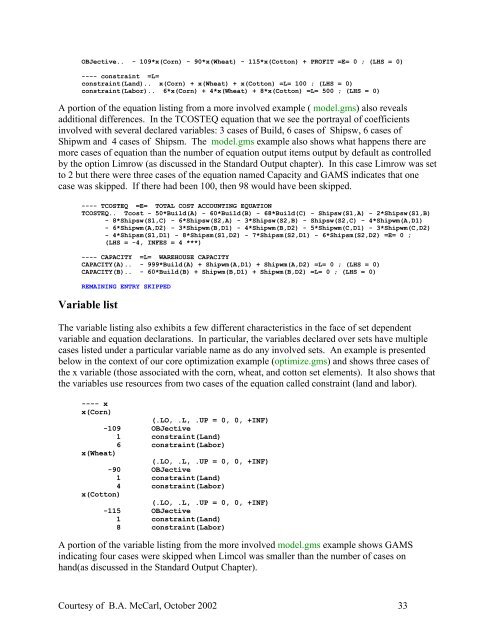You also want an ePaper? Increase the reach of your titles
YUMPU automatically turns print PDFs into web optimized ePapers that Google loves.
OBJective.. - 109*x(Corn) - 90*x(Wheat) - 115*x(Cotton) + PROFIT =E= 0 ; (LHS = 0)<br />
---- constraint =L=<br />
constraint(Land).. x(Corn) + x(Wheat) + x(Cotton) =L= 100 ; (LHS = 0)<br />
constraint(Labor).. 6*x(Corn) + 4*x(Wheat) + 8*x(Cotton) =L= 500 ; (LHS = 0)<br />
A portion of the equation listing from a more involved example ( model.gms) also reveals<br />
additional differences. In the TCOSTEQ equation that we see the portrayal of coefficients<br />
involved with several declared variables: 3 cases of Build, 6 cases of Shipsw, 6 cases of<br />
Shipwm and 4 cases of Shipsm. The model.gms example also shows what happens there are<br />
more cases of equation than the number of equation output items output by default as controlled<br />
by the option Limrow (as discussed in the Standard Output chapter). In this case Limrow was set<br />
to 2 but there were three cases of the equation named Capacity and GAMS indicates that one<br />
case was skipped. If there had been 100, then 98 would have been skipped.<br />
---- TCOSTEQ =E= TOTAL COST ACCOUNTING EQUATION<br />
TCOSTEQ.. Tcost - 50*Build(A) - 60*Build(B) - 68*Build(C) - Shipsw(S1,A) - 2*Shipsw(S1,B)<br />
- 8*Shipsw(S1,C) - 6*Shipsw(S2,A) - 3*Shipsw(S2,B) - Shipsw(S2,C) - 4*Shipwm(A,D1)<br />
- 6*Shipwm(A,D2) - 3*Shipwm(B,D1) - 4*Shipwm(B,D2) - 5*Shipwm(C,D1) - 3*Shipwm(C,D2)<br />
- 4*Shipsm(S1,D1) - 8*Shipsm(S1,D2) - 7*Shipsm(S2,D1) - 6*Shipsm(S2,D2) =E= 0 ;<br />
(LHS = -4, INFES = 4 ***)<br />
---- CAPACITY =L= WAREHOUSE CAPACITY<br />
CAPACITY(A).. - 999*Build(A) + Shipwm(A,D1) + Shipwm(A,D2) =L= 0 ; (LHS = 0)<br />
CAPACITY(B).. - 60*Build(B) + Shipwm(B,D1) + Shipwm(B,D2) =L= 0 ; (LHS = 0)<br />
REMAINING ENTRY SKIPPED<br />
Variable list<br />
The variable listing also exhibits a few different characteristics in the face of set dependent<br />
variable and equation declarations. In particular, the variables declared over sets have multiple<br />
cases listed under a particular variable name as do any involved sets. An example is presented<br />
below in the context of our core optimization example (optimize.gms) and shows three cases of<br />
the x variable (those associated with the corn, wheat, and cotton set elements). It also shows that<br />
the variables use resources from two cases of the equation called constraint (land and labor).<br />
---- x<br />
x(Corn)<br />
(.LO, .L, .UP = 0, 0, +INF)<br />
-109 OBJective<br />
1 constraint(Land)<br />
6 constraint(Labor)<br />
x(Wheat)<br />
(.LO, .L, .UP = 0, 0, +INF)<br />
-90 OBJective<br />
1 constraint(Land)<br />
4 constraint(Labor)<br />
x(Cotton)<br />
(.LO, .L, .UP = 0, 0, +INF)<br />
-115 OBJective<br />
1 constraint(Land)<br />
8 constraint(Labor)<br />
A portion of the variable listing from the more involved model.gms example shows GAMS<br />
indicating four cases were skipped when Limcol was smaller than the number of cases on<br />
hand(as discussed in the Standard Output Chapter).<br />
Courtesy of B.A. McCarl, October 2002 33
















